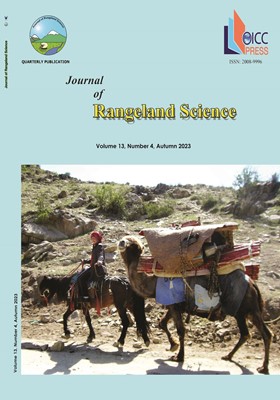Multihazard Rangelands Susceptibility Mapping (Drought, Flood, and Fire) in Siah Bisheh Watershed in North of Iran
محورهای موضوعی : Ecology, Autecology and SynecologySoodeh Miarrostami 1 , Hossein Arzani 2 , Seyed Akbar Javadi 3 , Mohammad Hassan Jouri 4
1 - Range Land Management,Natural Resources Faculty, Islamic Azad University of Science and Research Branch
2 - University of Tehran
3 - Department of Range Management, Science and Research Branch Islamic Azad University, Tehran, Iran
4 - Department of Rangeland, Natural Resources Faculty, Islamic Azad University Nour Branch. Nour, Iran
کلید واژه: risk management, Multi-Criteria Decision Making, Frequency Ratio, natural hazards, Multi-hazards, Chalous Rud,
چکیده مقاله :
This study was conducted to prepare a map of multi-hazard (drought, fire, and flood) to manage the rangelands of the Siah Bisheh watershed located in the west of Mazandaran province, Iran, Iran from 2017 to 2018. For drought assessment, the Standardized Precipitation Index (SPI) was used using the rainfall data of 21 meteorological stations for a period of 30 years. The multi-criteria decision-making method was used to weigh the existing layers and prepare the fire risk map. The results of the drought investigation showed that the study area was in a severe to moderate drought range with an SPI of -2.14 to -0.76, and most of the adjacent areas were also in the normal and near normal drought class. The vegetation types Bromus tomentolus-Festuca ovina and Festuca ovina-Bromus tomentolus were observed in the areas with higher drought susceptibility. The fire investigation showed that distance from the village (0.249), litter (0.166), and rainfall (0.151) were the most effective factors than others, respectively. The fire risk map showed that the northern part of the study area was highly susceptible to fire. Moreover, the rangeland of the study area was not affected by flood risk, and only the areas around the river were affected by floods. The results of the drought, fire, and flood risk maps of the study area showed that the central and northern parts of the watershed were of high and very high susceptibility in terms of multi-hazards. Based on the results obtained from flood modelling using the frequency ratio method, it was determined that this method had an efficiency of 0.98 based on receiver operating characteristic criteria. To determine the final risk map of the Siah Bisheh sub-basin, the drought, fire, and flood risk maps were consolidated. According to the final risk map, generally, the central and northern parts of the basin showed high and very high susceptibility in terms of multi-hazards. This research is useful in areas such as Iran and saves time and cost on studies.


